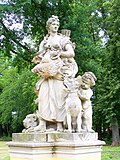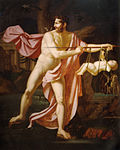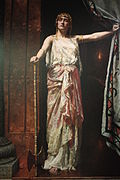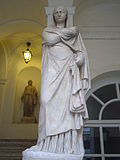List of 999 women of the Heritage Floor / Sophia
This list describes the place settings for Sophia on the table of Judy Chicago's art installation The Dinner Party . It is part of the list of 999 women on the Heritage Floor who are assigned to the respective place settings on the table. The names of the 999 women are on the tiles of the Heritage Floor, which is arranged below the table and belongs to the art installation.
description
The installation consists of a three-sided table, each with 13 historical or mythological personalities, thus a total of 39 people, from prehistory to the women's rights movement . These people were assigned a place setting at the table, consisting of an individually designed table runner, an individually designed plate, a goblet, knife, fork, spoon and serviette. The first page of the table is devoted to prehistory up to the Roman Empire , the second to Christianization up to the Reformation and the third from the American Revolution to the women's movement. Each place setting on the table is assigned additional personalities who have received an entry on the tiles of the Heritage Floor, which occupies the space under the table and the center of the space between the sides of the table. This list includes the personalities who are assigned to the table setting of Sophia. Your seat is on the first side of the table.
Hints
In addition to the names as they are used in German transcription or in scientific usage, the list shows the spelling chosen by Judy Chicago on the tiles.
The information on women who do not yet have an article in the German-language Wikipedia is referenced by the individual references listed under comments . If individual information in the table is not referenced via the main article, additional individual references are given at the relevant point. If there are any discrepancies between the information provided in Wikipedia articles and the descriptions of the work of art on the Brooklyn Museum website , this will also be indicated under Comments.
Place setting for Sophia

The goddess of wisdom, whose name is Sophia in Greek, has a multitude of different manifestations in almost every society. For example, Athena is considered the Greek goddess of wisdom and military victory, Minerva is the Roman goddess of wisdom and war, Tara is the Buddhist goddess of enlightened wisdom and Inanna was the Sumerian goddess of wisdom. Sophia is associated with the various incarnations of sacred feminine knowledge and the goddesses listed above.
In Gnosticism Sophia is a central figure. Gnosticism emphasizes individual knowledge and wisdom as the way to salvation and to unity with God. Her followers venerate Sophia as the divine creator and counterpart to Jesus Christ . According to Gnostic beliefs, Christ had two aspects: a male half, identified as the Son of God, and a female half, Sophia, who was venerated as the mother of the universe. According to John's Apocryphon , a pseudepigraphic gospel of dialogue , Sophia embodied divine wisdom and the feminine spirit. According to the Gnostic creation story, Sophia also wanted to create something when she saw God's creations and she gave birth to her son Yaldabaoth . This one has the body of a snake and the face of a lion. Through the power of Sophia he created the world and Sophia is thus revered as the mother of the universe.
Sophia is mentioned in the Bible as a feminine personification of wisdom, and in Kabbalah she is also described as a feminine expression of God. Many religious figures worshiped Sophia throughout history. To them belonged Hildegard von Bingen . After the advent of the modern feminist movement in the 1970s, Sophia has grown in popularity as a figure worshiping a goddess. There have been scientific efforts to historically localize Sophia as a goddess in the context of Christian religious practices, texts and images. One of these theories relates to Michelangelo's painting on the ceiling of the Sistine Chapel. Some scholars and art historians believe that the female figure under God's left arm in the creation of Adam is actually Sophia, who exercises her role as a feminine being in the creation of life and man.
A place setting is dedicated to Sophia on the table of the art installation The Dinner Party . The plate of the place setting is designed with the image of a flower, with petals in the outer circle and a white center. This white surface stands for the original divine nature of the goddess of wisdom and her strength as a creative force in the universe. The floral design can also be found in the table runner. For Judy Chicago, Sophia's place at the table stands for the decline of female power, especially religious power after the development of Christianity into the new religion. The design of the place setting should convey the transformation in the society of Sophia from a goddess of wisdom and female strength to a purely spiritual image, which only plays a subordinate role for the male figures of Christianity.
| Surname | Spelling on the tile | Date of birth | cultural spatial assignment | Remarks | image |
|---|---|---|---|---|---|
| Antigone | Antigone | N / A | Greek mythology | Tragic character from the Greek myth. She was the daughter of Oedipus and opposed King Creon, who condemned her to die by locking her up in a cave. |

|
| Arachne | Arachne | N / A | Greek mythology | Inventor of woven fabric and netting. Disgruntled Athena , the patron goddess of weaving, by boasting that her skills were greater than those of the deity. For this she was turned into a spider. |

|
| Atalante | Atalanta | N / A | Greek mythology | Legendary virgin huntress, warrior and sportswoman who did not want to get married was loved by the hero Meleager . |

|
| Camilla | Camilla | N / A | Roman mythology | Amazonian warrior of Roman mythology. |

|
| Daphne | Daphne | N / A | Greek mythology | Mountain nymph and a virgin huntress. |

|
| Hecabe | Hecuba | N / A | Greek mythology | In Homer's Iliad, the queen of Troy and wife of Priam . |

|
| Helena | Helen of Troy | N / A | Greek mythology | The daughter of Zeus and Ledas, born from an egg . |

|
| Hersilia | Hersilia | N / A | Roman mythology | Belonged to the robbed Sabine women and became the wife of Romulus , the legendary founder of the city of Rome . Mediated the understanding between the Sabines and the Romans. |

|
| Kassandra | Cassandra | N / A | Greek mythology | In ancient mythology she is considered a tragic heroine who always foresaw disaster but never found a hearing. Such unheard warnings are called cash register calls. |

|
| Kirke | Circe | N / A | Greek mythology | Sorceress of Greek mythology. Daughter of the sun god Helios and the Oceanids , Perse and the sister of king Aietes of Colchis and the Pasiphaë . Medea is her niece. |

|
| Clytaimnestra | Clytemnestra | N / A | Greek mythology | Daughter of the Spartan king Tyndareus and Leda , wife of the Mycenaean king Agamemnon and sister of the beautiful Helena . Killed her husband. |

|
| Lysistrata | Lysistrata | N / A | Ancient Greece | Heroine of the play of the same name by the Greek poet Aristophanes . |

|
| Pandora | Pandora | N / A | Greek mythology | A woman made of clay by Hephaestus . From Hermes she will Epimetheus brought - including the disastrous Pandora's box . |

|
| Praxagora | Praxagora | N / A | Ancient Greece | Protagonist of the classic Greek comedy The Women's People's Assembly . | |
| Pythia | Pythia | N / A | Ancient Greece | Pythia was the name for the officiating prophetic priestess in the oracle of Delphi , who preached her prophecies in altered states of consciousness . |

|
| Rhea Silvia | Rhea Silva | N / A | Roman mythology | King's daughter and mother of Romulus and Remus , who, according to legend, founded Rome . |

|
| Sibyl of Cumae | Sibyl of Cumae | 6th century BC Chr. | Roman Empire | According to tradition , she was a priestess from Babylon who lived in the 6th century BC. BC presided over the oracle of Cumae near Naples . |

|
| Vesta | Vesta | N / A | Roman mythology | Goddess of the ancient Italian, especially the Roman religion . She was the chaste keeper of the sacred fire. |

|
| Verginia | Virginia | N / A | Roman Republic | Her honor killing, committed by her father who wanted to protect her, led to a political revolt in Rome that overthrew the power of the Decemviri and restored the republic. |

|
- Individual evidence
- ↑ a b Brooklyn Museum: Sophia. In: brooklynmuseum.org. Retrieved October 3, 2019 .
Web links
- Brooklyn Museum, Sophia
- The Dinner Party on the website of Through the Flower , Judy Chicago's non-profit organization